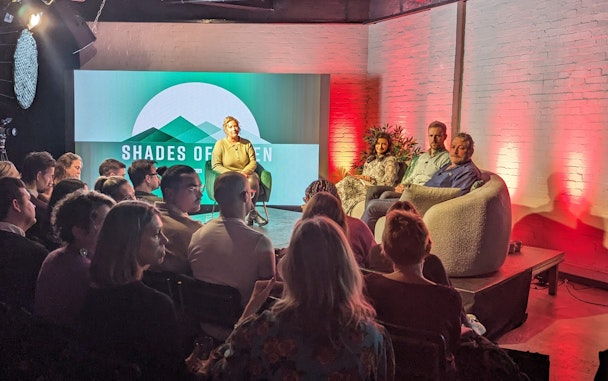Consumers expect brands to solve the sustainability crisis – but how can they do it?
Consumers are ripe for taking action when it comes to being more sustainable – but how can brands educate and communicate to make better choices? Leaders from Wavemaker, New Scientist and Mail Metro Media shed light on new ‘Shades of Green’ research to help navigate the nuances.

Mail Metro Media takes over The Drum Labs to launch latest flagship research
Sustainability in marketing has become more than a buzzword; it’s now a cornerstone of brand strategy. Environmental concerns are universal – albeit manifesting in different ‘shades of green’ across society – but there’s an expectation on brands and businesses to do the right thing by helping consumers take small sustainable steps to make the biggest difference.
At an exclusive launch event in The Drum Labs in London, Luke Hand and Richard Lay from Mail Metro Media’s Insights team revealed the diverse approaches individuals take towards sustainability as part of its ‘Shades of Green’ research. It found that 78% of UK consumers see climate change as an important issue for them – yet in the context of the current cost of living crisis, the environment falls lower in their list of priority issues right now.
Delving deeper into the findings, a panel of industry leaders explored the lessons and learnings for brands navigating the nuances of sustainable decision making in this evolving landscape.
Quality concerns
In a straight shootout, the research found that sustainability loses out to value, quality and convenience – underpinned by the perception among consumers that making sustainable choices come with a high price and compromised quality (especially in clothing and grocery).
This calls for a balanced approach to sustainability and quality. There’s power in smart communication from brands, said Monica Majumdar, head of strategy at Wavemaker UK, noting that brands should highlight quality and utility alongside sustainability, to make it easier for consumers to adopt eco-friendly choices without having to compromise.
The challenge for brands is to be able to dial up messaging based on what is most important to their audiences at that time. “If you change your messaging to first focus on the value and quality in the long-term life cycle of your product, and it’s also greener, it’s better for the consumer,” said Ryan Uhl, chief brand strategy officer at Mail Metro Media.
“We’ve got to find that nuance of why someone cares, and tailor content to address them. Going in with a green first message can put people off if you’re not talking about the other qualities of your product. By focusing on the right nuance, you get everyone to take a little step forward by choosing the right communication for the audience you’re trying to target.”
Advertisement
Communications breakdown
But, as the research highlights, there’s a disconnect between what brands think they should say versus what consumers understand. While they often see green terms used in ads (55%), on packaging (40%) and in social media (23%), just 9% are talking about them in daily conversations.
It comes down to information, understanding and education. This requires a real effort from brands to decode and simplify language to help consumers make the smarter choice.
“There needs to be uniform understanding about what it means and helping consumers understand how you’re helping them be more sustainable,” said Majumdar. “Think about the simple ways that can help consumers take that small action or step – but don’t make it seem so daunting. Don’t beat them with jargon for the sake of saying ‘look, we’re the greener option’ – which may not be true.”
It’s also important “not to define your communications message based on what your own internal sustainability team has told you is the thing you should be saying,” added Uhl. “If you create an ad, show it to real people – the people you are trying to communicate to – and ask them if they understand it. If they don’t, then you might need to rethink it.”
Contrary to popular belief, the research shows that older cohorts demonstrate equal concern for putting sustainability first in decision making – just as much as the perceived younger ‘eco-warrior’ Gen Z audience, so brands should be addressing diverse demographics. “We tend to respond to the most vocal, but we could potentially make bigger changes if we speak to that older audience who can actually speak with their pounds and show how brands can help them,” said Majumdar.
Advertisement
Quashing carbon claims
Advertising can be used to educate, inform and get people to make better, more informed choices and place more sustainable behaviours – and creating engaging, memorable ads is an effective way to reduce carbon footprint by balancing impactful media with sustainable reduction methods.
“If we’re producing good ads that are memorable and have the effect that they’re supposed to have, then that’s a good use of carbon,” said Uhl. “If I create a bad ad that no one likes, remembers or is just boring, that’s a bad use of carbon. We can also link carbon emissions with attention outcomes very simply through eye tracking studies. For example, video skins and video pre-roll drive significantly more attention than smaller standard ads and may be more effective for advertising impact – meaning you can serve less and reduce waste and, in turn, emissions.”
There doesn’t have to be a trade-off between an effective campaign with great ROI or a carbon neutral campaign. To knock that misconception on the head, Wavemaker has been working with brands to look at eco effectiveness and the metric of return on carbon.
“It’s about making smarter choices within your media mix,” said Majumdar. “Being able to bring the two together has been transformational. You can have an effective campaign and reduce the carbon emissions from it as well.”
Optimism ahead
There’s prevailing optimism ahead – particularly in technological advancements, scientific progress, and the growing consumer desire for sustainability.
“We couldn’t have said this 10 years ago, but we know how to do it now,” said Graham Lawton, staff writer for the New Scientist. “We have most of the technology, we have the knowledge about how to get to net zero, there’s still time just to get to that 1.5-degree ceiling and things seem to be moving in the right direction.”
For brands embarking on sustainability journeys, the collective recommendations were clear: simplify communication, embrace consumer expectations, and embody transparency. As for actionable insights, brands should think about crafting messaging that resonates across diverse demographics, making sustainability more accessible, and fostering a collective commitment.
The responsibility for reducing environmental impact is placed on businesses, not individuals. There is first mover advantage for businesses to lead and use every touchpoint to build it into people’s behavior. But these practices need to be genuine, authentic and linked to their business – or consumers will see right through it. “Consumers expect businesses to solve this problem, and businesses can solve the problem by doing the right thing – so do the right thing,” said Lawton.
To explore the full findings from Mail Metro Media’s ‘Shades of Green’ research, click here.
Content created with:

Mail Metro Media
Mail Metro Media is the advertising home of dmg media, representing the UK’s most engaged media brands: Daily Mail, The Mail on Sunday, MailOnline, Metro, i newspaper,...
Find out more
